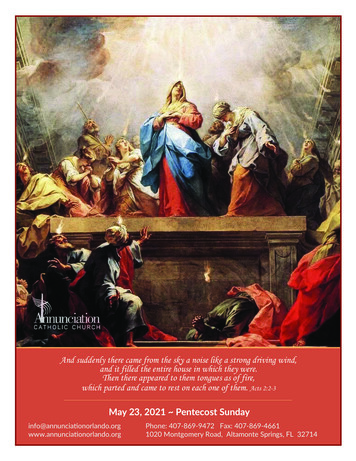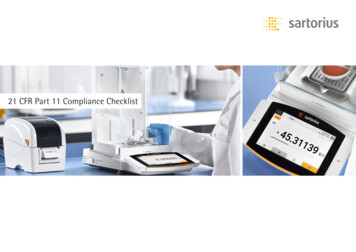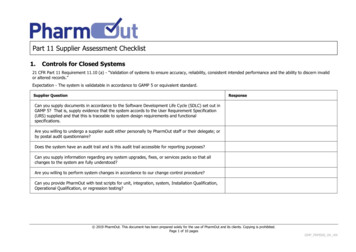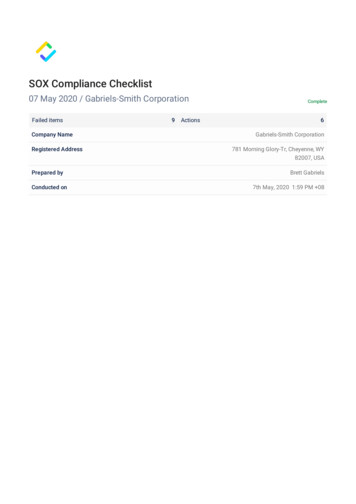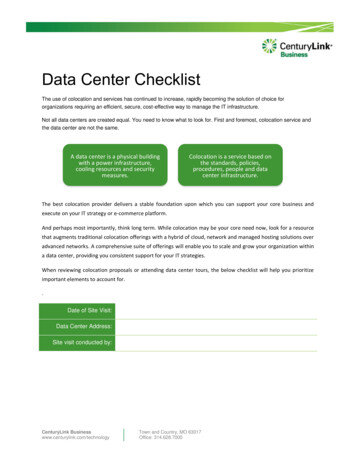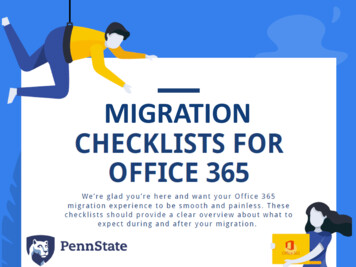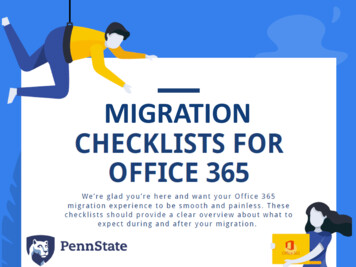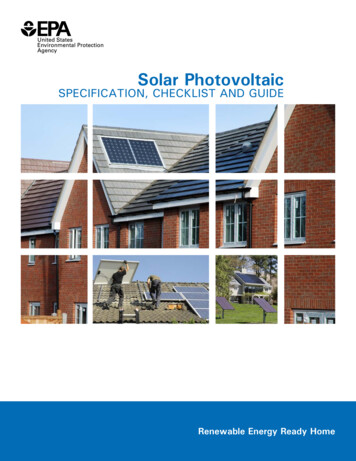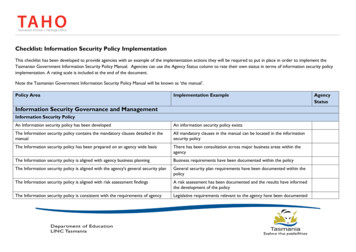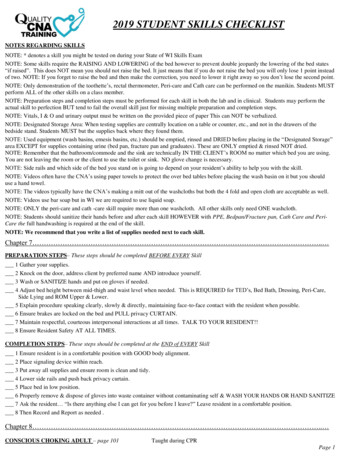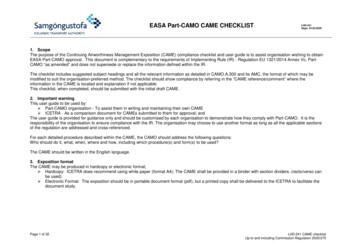
Transcription
EASA Part-CAMO CAME CHECKLISTLHD-241Dags. 24.03.20201. ScopeThe purpose of the Continuing Airworthiness Management Exposition (CAME) compliance checklist and user guide is to assist organisation wishing to obtainEASA Part-CAMO approval. This document is complementary to the requirements of Implementing Rule (IR) - Regulation EU 1321/2014 Annex Vc, PartCAMO “as amended” and does not supersede or replace the information defined within the IR.The checklist includes suggested subject headings and all the relevant information as detailed in CAMO.A.300 and its AMC, the format of which may bemodified to suit the organisation-preferred method. The checklist should show compliance by referring in the “CAME reference/comment” where theinformation in the CAME is located and explanation if not applicable.This checklist, when completed, should be submitted with the initial draft CAME.2. Important warningThis user guide to be used by: Part-CAMO organisation - To assist them in writing and maintaining their own CAME ICETRA - As a comparison document for CAMEs submitted to them for approval; andThe user guide is provided for guidance only and should be customised by each organisation to demonstrate how they comply with Part-CAMO. It is theresponsibility of the organisation to ensure compliance with the IR. The organisation may choose to use another format as long as all the applicable sectionsof the regulation are addressed and cross-referenced.For each detailed procedure described within the CAME, the CAMO should address the following questions:Who should do it, what, when, where and how, including which procedure(s) and form(s) to be used?The CAME should be written in the English language.3. Exposition formatThe CAME may be produced in hardcopy or electronic format; Hardcopy: ICETRA does recommend using white paper (format A4); The CAME shall be provided in a binder with section dividers. (recto/verso canbe used) Electronic Format: The exposition should be in portable document format (pdf), but a printed copy shall be delivered to the ICETRA to facilitate thedocument study.Page 1 of 32LHD-241 CAME checklistUp-to and including Commission Regulation 2020/270
4. Structure of the Continuing Airworthiness Management ExpositionThe CAME may be produced in the form of a single document or may consist of several separate documents. Single document: The standard CAME produced i.a.w. AMC1 CAMO.A.300 is a unique and complete document. It must contain all the informationrequired to show compliance with the regulation, including detailed continuing airworthiness management procedures and detail of the managementsystem (see AMC1 CAMO.A.300 and Appendix V to AMC1 CAMO.A.300). Several documents: The CAME must contain at least the information as detailed in Appendix V to AMC1 CAMO.A.300 Part 0.1 to 0.7 (Generalorganisation). The additional material may be published in separate documents which must be referenced from the CAME. In this case: The CAME should cross-refer to the associated procedures, documents, appendices and forms, which are managed separately.These associated documents must meet the same rules as described for the CAME.This/these associated document(s), procedure(s) and form(s) etc. must be provided to ICETRA as part of the CAME.For some organisations individual sections of the headings defined within AMC1 CAMO.A.300 and Appendix V to AMC1 CAMO.A.300 maybe ‘not applicable’.In this case, they should be annotated as such within the CAME.5. Exposition pages’ presentationEach page of the CAME should be identified as follows (this information may be added in the header or footer; the name of the organisation (official name as defined on the EASA Form 14 approval certificate) the issue number of the CAME the amendment/revision number of the CAME the date of the revision (amendment or issue depending on the way the organisation has chosen to revise the CAME) the chapter of the CAME the page number the name of the document "Continuing Airworthiness Management Exposition”.At the beginning of the volume, the Cover page should specify: Continuing Airworthiness Management Exposition; The name of the organisation (the official one defined on the EASA Form 14 approval certificate) The approval reference of the CAMO The copy number from the distribution list (if applicable)6. Corporate commitment by Accountable MangerPrior to the submission of the ‘draft’ CAME to the ICETRA for approval, the accountable manager must sign and date the accountable manager statement(General organisation 0.1). This confirms that they have read the document and understand their responsibilities under the approval. When the accountablemanager is not the chief executive officer (CEO) of the organisation, then such CEO shall countersign the statement. In the case of change of the accountablemanager, the new incumbent should sign the document and submit a suitable amendment the ICETRA for approval.CAME referenceOrganisation official nameDateSummited byPage 2 of 32LHD-241 CAME checklistUp-to and including Commission Regulation 2020/270
CAME checklistCompl.ContentIR referenceCAME reference / commentCover page Continuing Airworthiness Management ExpositionThe official name of the organisation as defined on EASA Form 14The approval reference of the CAMOThe copy number from the distribution list (if applicable)Introduction ForewordTable of contentList of effective pages List of issues/amendments or record of revision ICETRA Letter of Approval (LOA) CAMO.A.30(11)(iv),(v)Identify how the revision is approved, i.e. direct approved byICETRA or indirectly (changes not requiring prior approval)The organisation internal approval page. This page is signed by thecompliance manager and the nominated person or CAMO post holder(as applicable).Internal approval statementTitle, name, date and signatures Revision highlights / Summary of changes The effective date of the current revisionThe effective date is the date that the amendment introduced in thisamendment takes effectThe effective date can be established just prior to the final approvalof the CAME or just after. This is to obtain the necessary time toincorporate the amendment, e.g. to train personnel, print forms etc. Page 3 of 32Distribution listCAME copy number (if applicable)Location of copiesHolders of the copiesLHD-241 CAME checklistUp-to and including Commission Regulation 2020/270
Format of copies (electronic data processing (EDP), paper etc.) Abbreviation, terminology and definitionsCross-reference list from the CAME to AMC1 CAMO.A.300, if applicableAMC1 CAMO.A.300AMC1 CAMO.A.300 provides an acceptable layout of the CAME. If theorganisation uses a different format, then the exposition should containa cross-reference list using the AMC1 CAMO.A.300 as an index with anexplanation as to where the subject matter can be found in theexposition. Organisation information, i.e.: Address of approved locations (Head Office (PPB) etc.) Mailing Address(es) Telephone number(s) E-mail addressesThis can be included in 0.2.PART 0 GENERAL ORGANISATION, SAFETY POLICY ANDOBJECTIVES Page 4 of 320.1Safety policy, objectives and accountable manger (AM)statementThe safety policy must describe the overall philosophies and principlesof the organisation with regards to safetyThe accountable manager statement needs to be amended to cover allPart-M, Part-ML and Part-CAMO requirements, as applicableWhen the AM is not the CEO of the organisation, then such CEO shallcountersign the accountable manager 0(a)(2)AMC1 CAMO.A.200(a)(2)GM1 CAMO.A.200(a)(2)0.2 General information and scope of workDescription of the organisationRelationship with other organisationo Subsidiaries/mother companyo ConsortiumsA general description and location of the facilitiesLocation of facilitiesGeneral descriptiono Layout of premisesOffice accommodation for:o Planningo Technical recordso Compliance monitoringo Technical reference areao HD-241 CAME checklistUp-to and including Commission Regulation 2020/270
StorageScope of work - Aircraft managedo Quote aircraft types/serieso Date included in the scope of worko List of aircraft maintenance programmeso List of “generic” and “baseline” maintenanceprogrammeso Quote number of aircraft of each typeo Quote each aircraft registration (or elsewhere byagreement with ICETRA – see note 1 below)o List for each aircraft, aircraft owner/operatoro CAMO contract referenceType of operationOrganisation scope of work (scope of approval) CAMO.A.125(c)- see note 2 belowNote 1: It is crucial to be able to identify which aircraft is managed bythe CAMO at a given time, especially when it comes to determiningwhether or not an aircraft has remained in “controlled environment” andor when aircraft are removed from an AOC but will be kept managed bythe CAMO as a private aircraft. By only referring to the current list on theAOC, will automatically discontinue the aircraft from being managed bythe CAMO when removing the aircraft from the AOC. For large aircraft,that will automatically invalid the ARC.Note 2: The EASA Form 14 will refer to the section containing the Scopeof Approval (Scope of Work). Page 5 of 320.3 Management personnelAccountable ManagerNominated post holder for continuing airworthiness activitiesNominated safety managerNominated compliance managerAirworthiness Review staffNominated person(s) authorised to extend ARCNominated person(s) authorised to issue Permit to FlyMake it clear who require prior approval as per pointCAMO.A.130(a)(2)The duties, accountabilities, responsibilities and authorities (jobfunctions) of:o Accountable Managero Continuing Airworthiness Manageo Safety managero Compliance monitoring managero Airworthiness Review staffCAMO.A.300(a)CAMO.A.305(a)(b)LHD-241 CAME checklistUp-to and including Commission Regulation 2020/270
o Nominated person(s) authorised to extend ARCo Nominated person(s) authorised to issue Permit to FlyTitle(s) and name(s) of persons above (AR staff can be in 5.2)Ensure that one of the accountable manager responsibility is toestablish and promote the safety policy (CAMO.A.200) or safetyand quality policy if Part-145 approved as well, specified in point145.A.65(a) as required in point 145.A.30(a)(2).Manpower Resources ando Manpower Recourses table should show broad figuresof the number of staff assigned to CAMo Should show an adequate amount of staff vs scopeo The date the staff number is establishedo When the staff number will be updatedMan-hour plan development and updatingo All activities, also activities not performed under thePart-CAMO approvalo Include subcontracted organisation if applicableTraining Policyo Training Policyo How the training need is assessedo How the recurrent and continuing training is assessedo Recording and follow-up Page 6 of 320.4 Management organisation chartGeneral organisation chart showingContinuing Airworthiness Management Organisation ChartThe nominated persons as per CAMO.A.305 should beidentified in the chartCompliance monitoring personnel must be shown to beindependent of the continuing airworthiness management andmust report directly to the accountable managerThe organisation chart must show associated chains of accountabilityand responsibility between all the person(s) referred to in points (a)(3) to(a)(5), (b)(2), (e) and (f) of point CAMO.A.305, and related to point (a)(1)of point CAMO.A.200;CAMO.A.200(a)(1)CAMO.A.300(a)(7)0.5 Procedure for changes requiring prior approvalChanges that affect the scope of the certificate or the terms ofapproval of the organisationChanges to personnel nominated in accordance with points(a)(3) to (a)(5) and (b)(2) of point CAMO.A.305Changes to reporting lines between the persons nominated perpoints CAMO.A.305(a)(3) to (a)(5) and (b)(2), and theaccountable manager;CAMO.A.130CAMO.A.200(a)(3)GM1 CAMO.A.130GM1 CAMO.A.130(a)(1)GM2 CAMO.A.130(a)(1)GM1 CAMO.A.130(b)LHD-241 CAME checklistUp-to and including Commission Regulation 2020/270
The procedure as regards changes not requiring prior approvalreferred to in point CAMO.A.130(c)CAME procedure for the completion of an AR under supervision(CAMO.A.310(c))Changes listed in GM1 CAMO.A.130(a)(1)Notification before such changes take place (AMC1CAMO.A.130)Management of the safety risks related to any change to theorganisation per AMC1 CAMO.A.200(a)(3) point (e)Conduct risk assessment for any change requiring priorapproval and provide it to ICETRA upon requestInternal pre-audit before application Page 7 of 320.6 Procedure for changes not requiring prior approvalProcedure addressing:How the changes will be manageHow changes will be notified to ICETRAScope of changes not requiring prior )(iv)CAMO.B.330(e)0.7 Procedure for alternative means of compliance (AltMoC)Management of AltMoC – prior approvalSubmitting the AltMoC to ICETRAo Prior to using ito Provide a full description of the AltMoCo Revision of CAME procedureso Assessment demonstrating compliance with regulation(EU) 2018/1139 and its delegated and implementingactso Receiving notification from ICETRAo Listing of AltMoC in Part 5.7 Supporting .8 CAME amendment procedureExposition Amendment Procedures (including, delegated procedures)Amendments that need prior approvalAmendments not requiring prior approvalDescription of how such amendments will be managedThe person that is responsible for monitoring and amending theCAME, including the associated procedures as perCAMO.A.300(c)Normally the compliance manager is responsible for themonitoring, and control the amendments of the CAMESources of proposed amendments within the organisationInternal approval processVerifying and validation of amended procedures before useCAMO.A.300(a)(11)(v)LHD-241 CAME checklistUp-to and including Commission Regulation 2020/270
Techni
EASA Part-CAMO CAME CHECKLIST . LHD-241 . Dags. 24.03.2020 . 1. Scope The purpose of the Continuing Airworthiness Management Exposition (CAME) compliance checklist and user guide is to assist organisation wishing to obtain EASA Part-CAMO approval. This document is complementary to the requirements of Implementing Rule (IR) - Regulation EU 1321/2014 Annex Vc, Part- CAMO “as
